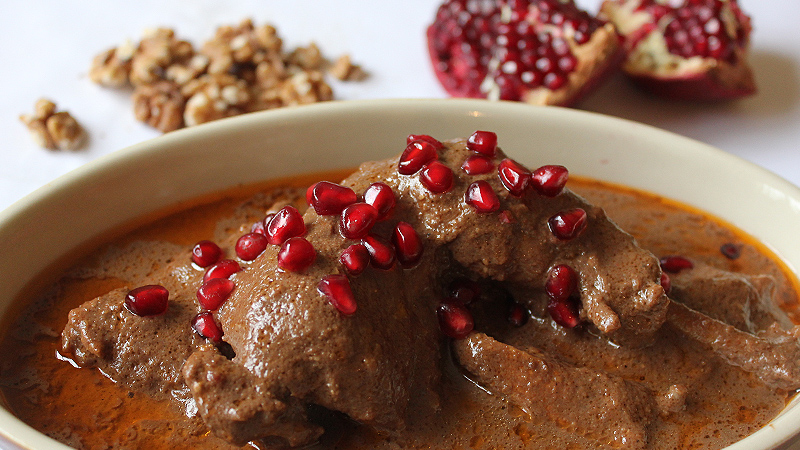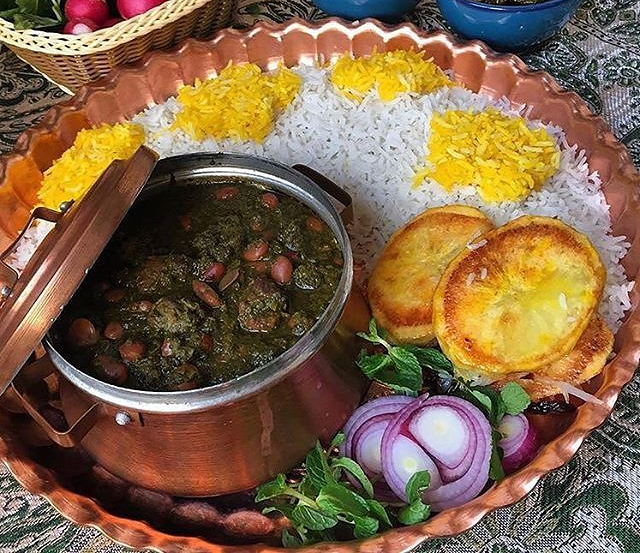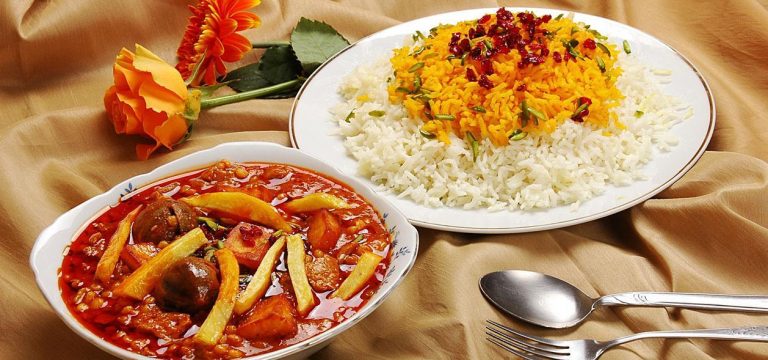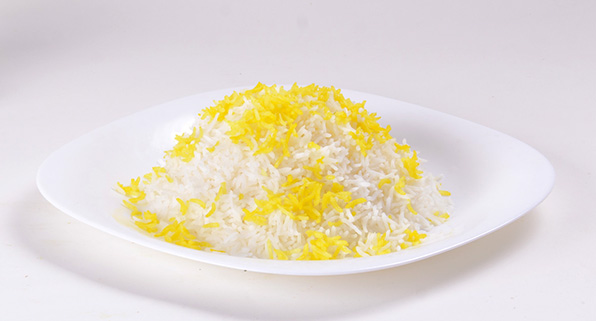The land of four seasons is one of the titles of Iran. Iran is similar to a beautiful painting. A vast and fertile land with a wide range of biodiversity and different climatic conditions promotes the prosperity of agriculture as the primary sector of the economy. That is one of the most influential factors in Persian Cuisine diversification, hats off to the production of different agricultural goods with superb quality.
Persian Cuisine culture is rich and has a long history that also represents ethnic differences. Persian Cuisine is an art because it requires training, practice, patience, taste, creativity, and courage. Tourists may not know the perfect taste of a stew or kebab, but Iranians could tell.
Cooking Persian Cuisine takes a lot of your time, but the results are worth it, to quote Adam Jones in the movie Burnt: they sit there with longing, and they stop in the middle to savor the flavor.
Khoresht-e-Fesenjan (Fesenjan Stew)
Type: Main course
Meal: Lunch and Dinner
Origin: Traditional Food of Gilan Province (in the north of Iran), but they make it in most parts of Iran.
As a Persian Cuisine, Iranian cooked Khoresht-e-Fesenjan many years ago. In old Iran, preparing this food was a representation of how winter ended and spring is coming. Accordingly, it was the official food of Nowruz.
That is very delicious, so traditionally and it is ceremonial food.
The ingredients are:
- chicken or duck
- ground walnut
- pomegranate molasses
In central parts of Iran, meatballs are sometimes used instead of chicken in this stew. Chefs and hosts serve Khoresht-e-Fesenjan with saffron rice (white rice with saffron).

Khoresht-e-Fesenjan
Khorsht-e-Ghormeh Sabzi (Khoresht-e-Sabzi)
Type: Main Course
Meal: Lunch and Dinner
Origin: In terms of etymology, Ghormeh is from the Turkish word Kavurmak which means braised, and Sabzi is a Persian word for herbs.
In Persian Cuisine, Chefs prepared Ghormeh in provinces where animal husbandry was very common, and the weather was cold. They cooked the fresh meat with fat (without bones) at a low temperature for hours. Then well-cooked meat was placed, for example, in a clay pot and stored in a cold place to use later. But because of the fat and salt in the Ghormeh meat, they mixed it with vegetables and onions to moderate its fat and salt. That is why Khoresht-e-Sabzi is also called Khoresht-e-Ghormeh Sabzi.
As a result, meat is one of the main ingredients for preparing most Persian Cuisine, especially this stew. We generally use mutton for this meal but sometimes veal is used in its place.
Other ingredients are:
- Red kidney beans or pinto beans
- Finely chopped herbs including parsley, Cilantro, Chives, and a Little dried fenugreek powder
- Dried limes (Limo Amani)
- Onion
They serve this food with white or saffron rice. The title of National Dish for this Persian food seems justified because it is a popular dish in Iran. When Iranian invite others to their home, the chance of having Ghorme Sabzi as one of the main dishes is heightened.
The history of this stew goes way back. But unlike most Persian Cuisine, its recipe has not changed much. Although, Ghormeh Sabzi was bold enough to embark upon new and modern paths, like becoming a type of Pizza (Which, to be fair, was not well-received by the public because not every novel idea results in a good-tasting meal).
The last Saturday of November, usually two days after Thanksgiving Day in the United States, is the international Ghormeh Sabzi day. An unofficial holiday to familiarize people of different cultures with Persian Cuisine and its history.

Khorsht-e-Ghormeh Sabzi
Khoresht-e-Gheymeh
Type: Main course
Meal: Lunch and Dinner
Most people believe that Khoreshet-e-Gheymeh is the king of Iranian stews. Even though it is old, original, and beloved, there is not an accurate history of the origin of this food.
In the Dehkhoda Dictionary (the largest comprehensive Persian dictionary ever published), Gheymeh is a Turkish word that means minced meat or meat cut into small pieces.
Meat (commonly lamb but beef is also used) is one of the main ingredients of this Persian Cuisine, and chefs must cut them into small cubes, and that is why this stew is called Khoresht-e Gheymeh because it’s unlike most Iranian foods that usually have large pieces of meat.
In Lahijan (a city near the Caspian Sea and Rasht, the capital of Gilan Province), they cook this Persian Cuisine with fried minced meat.
Other ingredients are:
- Yellow split peas
- Dried limes (Limo Amani)
- Tomato paste
- Cinnamon and saffron
It is interesting to know that when we garnish this stew with French fries it is called the Classic Gheymeh and when we use fried eggplant slices in it, it’s called Gheymeh Bademjan, which means Eggplant Gheymeh. Hosts serve both types of Gheymeh with white or saffron rice.

Khoresht-e-Gheymeh
Rice
Rice cultivation in Iran has a long history. Like many other countries, rice in Iran serves as the second most important staple food crop after wheat. There are beautiful green velvety rice fields with enticing aromas in different parts of Iran. The rice producer provinces are the northern provinces, and Gilan is known as the foremost rice provider in Iran. However, Kamfiruz in Fars Province has rice fields that could compete with Gilan. Rice in all its forms, whole grain, broken rice, and rice flour, is used in most recipes.
In Persian Cuisine, rice is the main ingredient for preparing various dishes, soups/pottages, and sweets/desserts. That shows how much rice-based nutrients could be variable, not to mention its place in Iranian cuisine.
Chefs cook Rice-based cuisine in different parts of the world. When you travel to Iran, you can experience a unique taste of Persian rice cooked based on a wide range of recipes. Here in Iran, among rice-based foods, Chelow and Polow are the most popular ones, two inseparable parts of Persian cuisine.
Both of them have a delicious, worth fighting for a piece, named Tah-Dig, a crispy crust at the bottom of the rice. Do not hesitate to try it, because it has so many devotees among Persians and fans of Persian Cuisine that you might not get any!
Chelow
In Persian Cuisine, Chelow means cooked plain white rice without additional ingredients served as an accompaniment to different kinds of stews and kebabs. Chefs cook Chelow of long-grained rice with excellent aroma and flavor.
For preparing chelow, rice is rinsed, soaked in salted water, parboiled, drained, and finally steamed by adding a little oil. This technique results in fluffy, separated, and non-sticky rice grains.

Chelow
Polow
In Persian Cuisine, the word Polow is the same as Pilav in Turkish. Polow means white rice mixed with a wide variety of ingredients such as meat, beans, vegetables, dried fruits, spices, or a combination of them according to the recipe and regional differences. These ingredients are added in layers or mixed with the rice, either at the post-boiling stage and then steamed or mixed with steamed rice.
In any case, by using each of these techniques, what you have at the end is delicious and colorful Persian Cuisine.

Polow
Last but Not Least, Tah Dig
The Iranian cooking style for preparing rice-based Persian Cuisine has unique differences from other parts of the world. The most important one is about Tahdig, which means the bottom of the pot. The word bottom, in Persian, is Tah, and the word pot means Dig. Tahdig is a deal-breaker. The skill of a chef is measured by how good the Tahdig comes out. If you make a disaster out of a stew, you can make everyone forget it by serving the best Tahdig.
At the bottom of the pot of Chelow or Polow, one can find an appetizing crispy crust. Tahdig forms itself during the steaming stage.
There are different local recipes for preparing a deliciously crispy Tahdig, but the rice Tahdig is the simplest readily browned crispy base of the Persian steamed rice.

Tah Dig
The most popular ones in addition to rice-Tahdig in Persian Cuisine are:
- A mixture of rice, yogurt, saffron, and egg (which makes the delicious Tahchin)
- Thinly slices of peeled potatoes
- Pieces of flatbread (mostly Lavash)
- Lettuce leaves
Interestingly, in Iran, spaghetti and other types of pasta are steamed somewhat like rice with slices of potato as Tahdig. Although this is a mortal sin in the eyes of many, especially Italians (because it’s the furthest from al dente pasta), we bet you cannot resist the temptation to eat this type of Tahdig.






